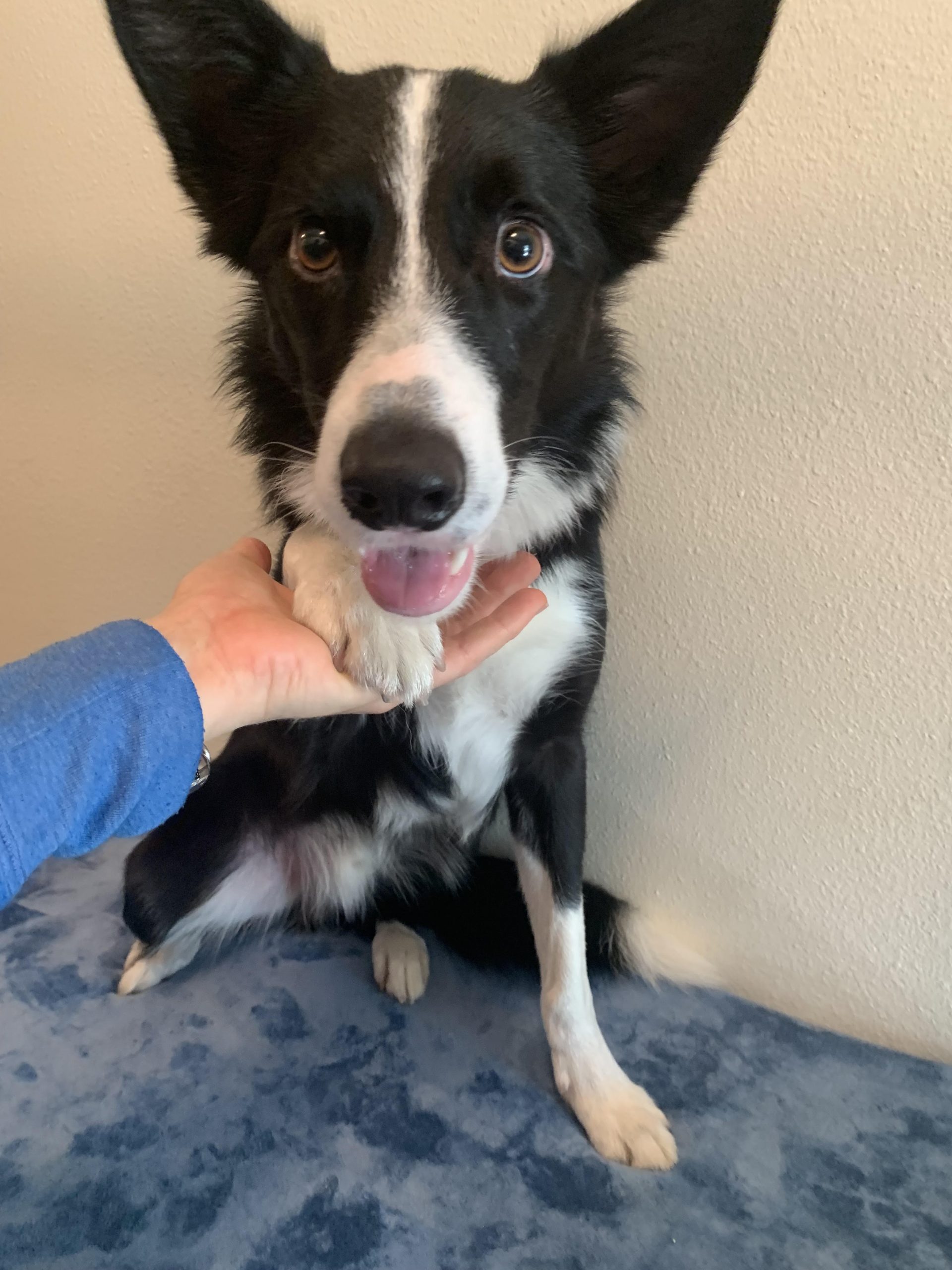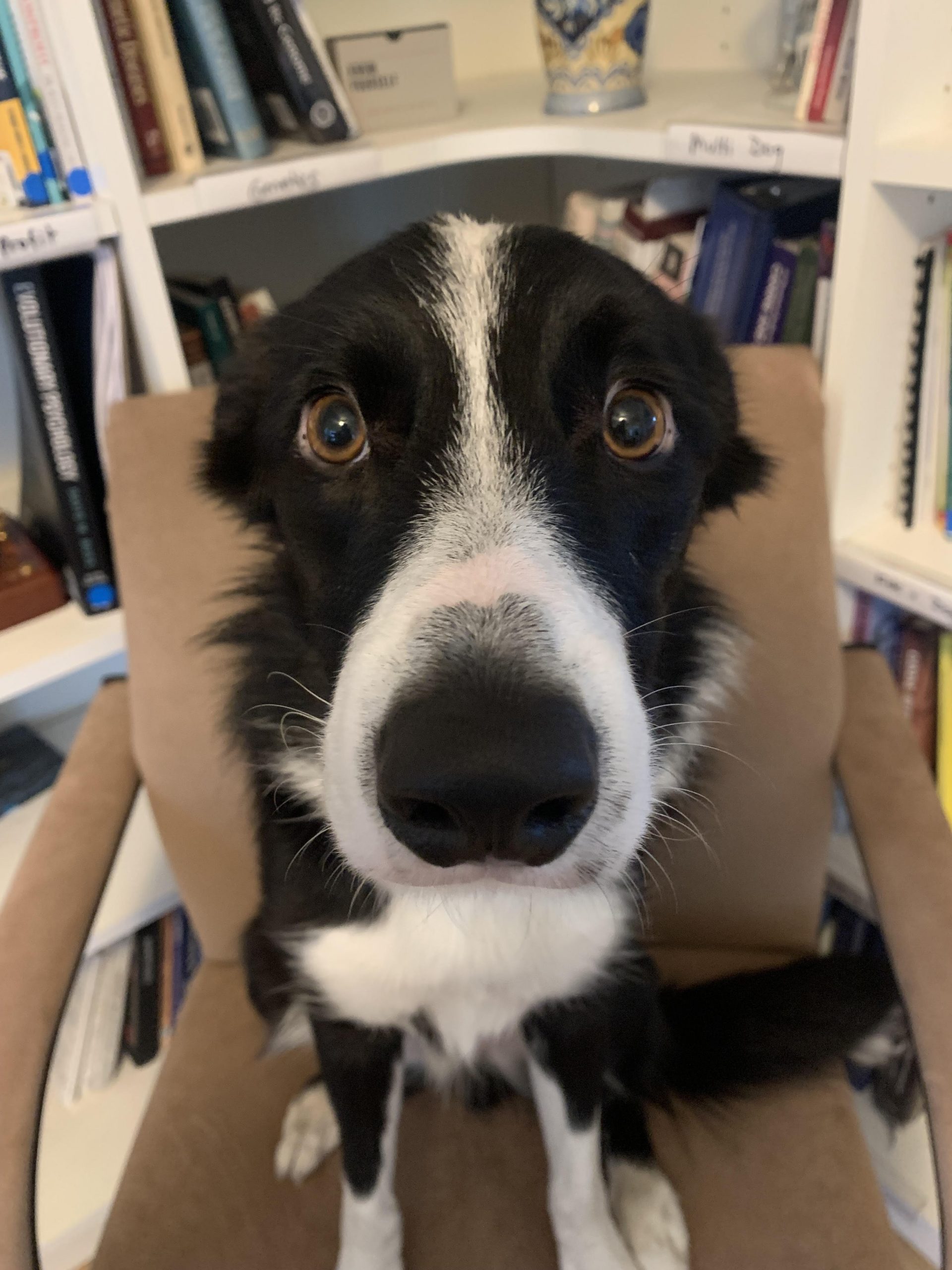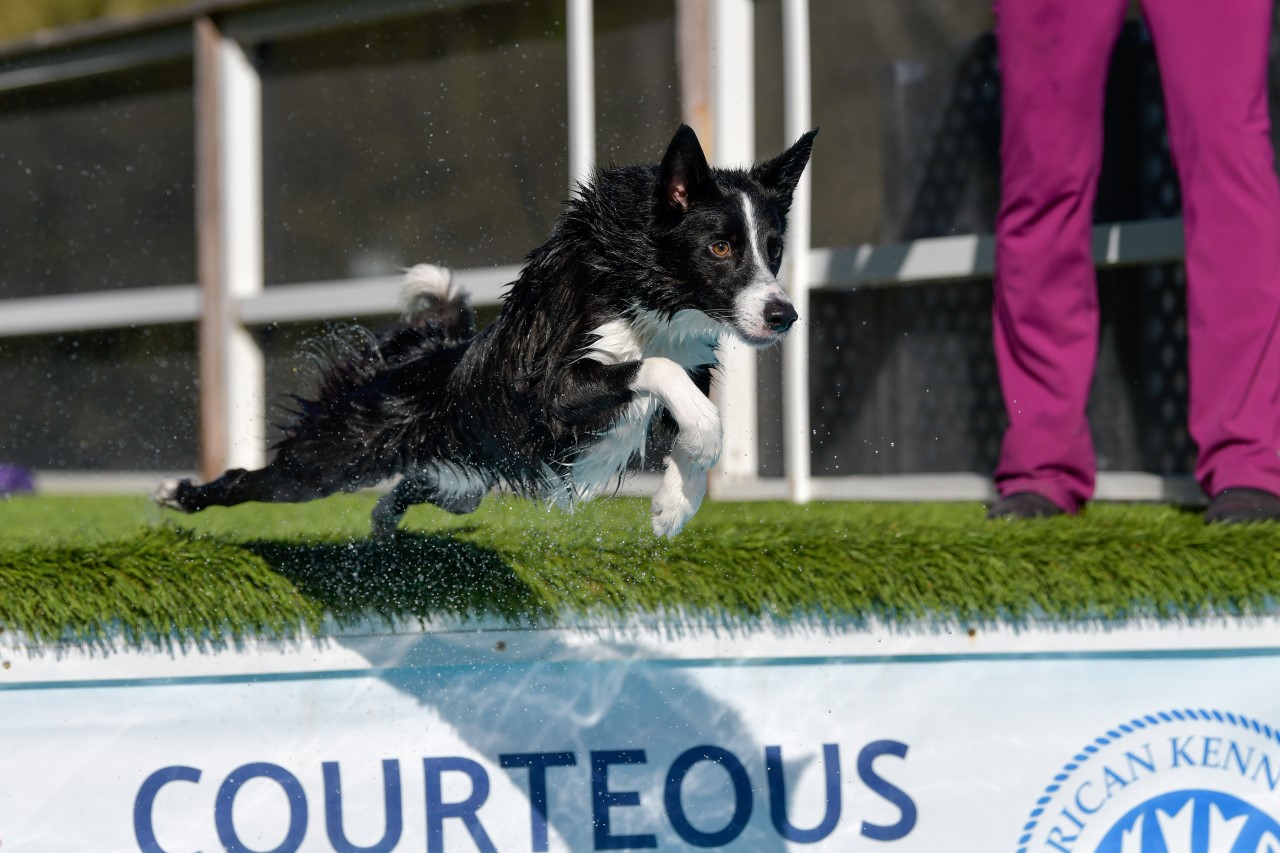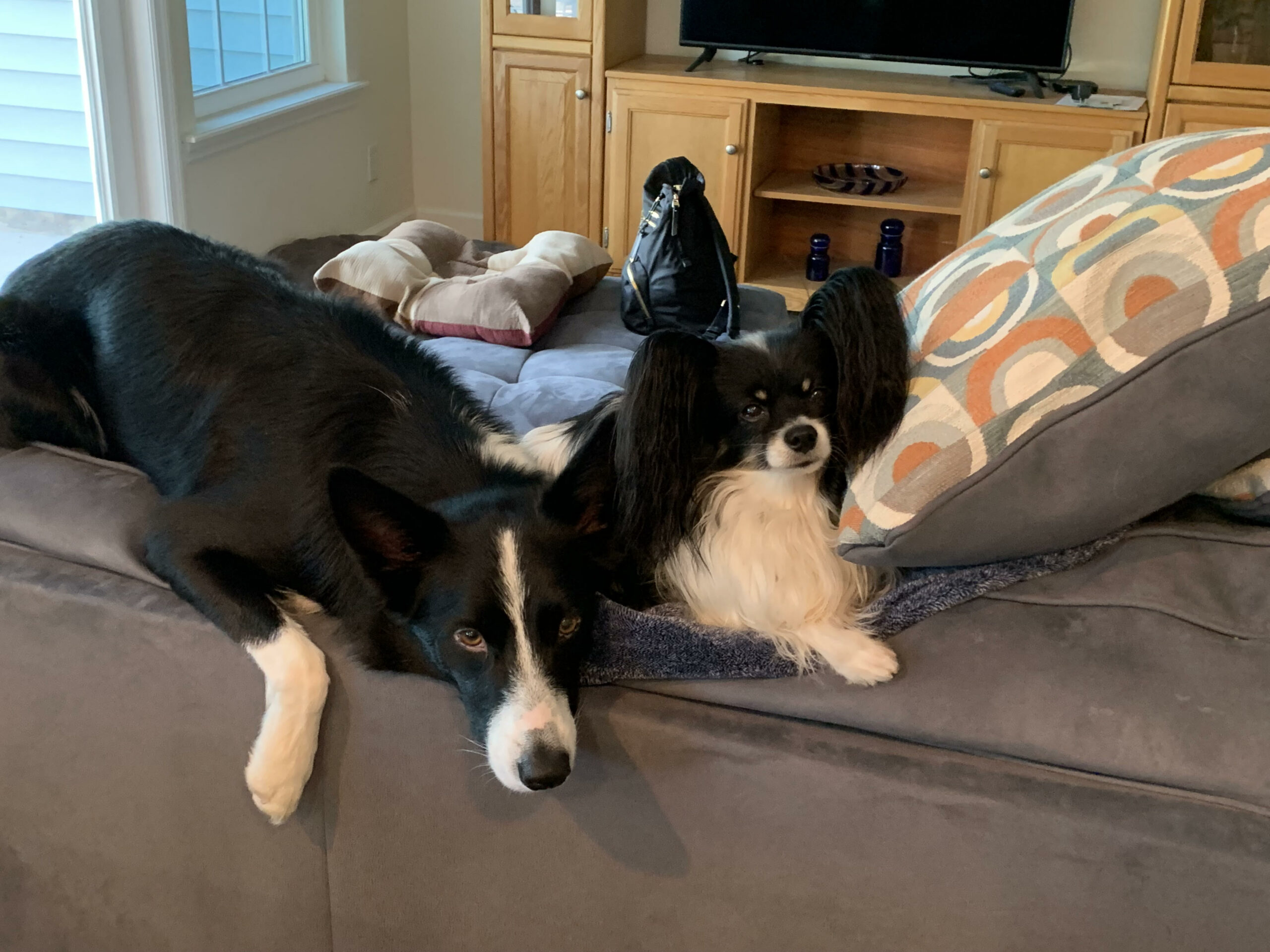Barks Blog
A Beautiful Life with a Visually Impaired Dog
This interview features Lutz, Florida-based trainer Angelica Steinker explaining how she discovered that her new puppy Particle was visually impaired, and outlining the environmental and management adjustments she has made to ensure he can still live his life to the fullest

By Susan Nilson
Puppy parent, professional dog trainer, and agility and dock diving specialist Angelica Steinker, founder and president of the Courteous Canine in Tampa, Florida, found herself with an unexpected challenge when she realized her newly adopted border collie puppy, Particle, was having issues with his vision.
Steinker noticed that Particle was struggling with aspects of his agility training, as well as more regular activities such as hand targeting and object tracking. A trip to the veterinary ophthalmologist revealed that Particle is farsighted and has monocular vision, leading Steinker down an investigative path to find out the best therapies for him, as well as creative ways to manage and modify his environment to ensure he still receives sufficient physical and mental stimulation.
Early Observations
BARKS from the Guild: How did you first notice there might be an issue with Particle’s vision in terms of his behavior?
Angelica Steinker: It was a gradual process. Every puppy you parent is different, so at first I thought the observations I made were just individual differences. Things like: I noticed he seemed more clumsy than any other puppy I had ever had, and that he had difficulty learning proprioception, i.e. where he was in relation to other beings and objects.
Teaching him turn on forehand was very challenging. Perching, two front feet on flat object was a bit better but things like hand targeting or dumbbell work were very slow.
He still can’t do hand targeting. He won’t attempt to look at hands or objects near his face. However, moving targets such as toys are much easier for him. This was of course confusing to me when I was attempting to learn about him as a being and only in hindsight do I have a clearer understanding.
His visual impairment applies much more to anything that falls outside of his central vision and to stationary beings or objects.
I also noticed that he would run into me a lot. Again, I thought that was just a clumsy puppy thing. During play, he would reposition and bite me accidentally much more than any other dog.
He is a very soft and biddable dog so both running into me and accidentally biting me is something that is stressful to him. If I say “ouch” he is very concerned and apologetic which makes me feel sad, since he is not doing it on purpose in the first place. He just can’t see where I end and he starts.

Weave Pole Training
The biggest thing was weave pole training. That’s when I became sure he was visually impaired.
Particle could weave full speed away from me completely independently of what I was doing, but the moment I changed his approach angle even slightly he could not find the entrance.
The standard way to work on this is to isolate the entrance training by working only three poles. But when doing this, I noticed the same thing: he could not see the three poles the moment the angles were different.
Also, sunlight and time of day were huge issues. If it was overcast afternoon time he could weave; if it was bright sun with shadows falling on poles he would run past them.
He was unable to generalize from one set of poles to another even if they were right next to each other. This makes me so sad to share because I realize how much this dog was trying to do this for me. He wanted to please me and do those weave poles, even though he could not even see exactly where they were.
Jump Training

With jump training, I also noticed problems. Basically, if he could not memorize the number of strides to a jump he could not keep the bar up. And jumping in extension was much more problematic than jumping in collection.
This means that if he was rounding his jumping more, he was likely more successful; if he was going faster, he was a lot less successful. In dog agility, his specific issue is called ETO (early take off). Much has been written on this topic and Clean Run Magazine has published an entire special issue on it.
Visual Stimuli
BARKS: What environmental/management changes did you make to accommodate him? Have you noticed that he responds differently to different colors or shapes?
AS: I am unable to gather this information outside of toys because Particle disengages visually. What I mean by this is that if something pushes him in terms of visual tracking, or providing too much information (or not enough), he simply turns his head and stops looking at it.
Visual stimuli that does not provide enough information can be overwhelming or punishing to him, so he opts not to engage with it.
I am working with this by gradually exposing him to visual stimuli that he can handle. We only play with one toy at a time and it is always the exact same toy. He has lots of toys in the house but his special toy for training is always the same. This is the toy that I toss. If we play tug we use a variety of toys.
In the house, if you send him to a specific toy, you can pretty much assume he will get just whatever is closest or most visually salient to him. He seems to gravitate to balls more than other shapes of toys.
Colors do not appear to be a noticeable thing to him but I would not dream of attempting to get him to focus on something like color.
Depth Perception
BARKS: What about his depth perception – does he respond in any way to puddles, shadows, objects that are moving (e.g. a flag flapping in the wind, a plastic bag blowing down the street), or other things that he may perceive differently?
AS: I think in retrospect he had probably more neophobia as a puppy than he would have if he had more normal vision. There were lots of things he was afraid of that now, in hindsight, I would guess were because they suddenly appeared, or the lighting was such that he was visually surprised.
Mostly, I noticed it with other dogs. He was afraid of a lot of dogs but in a way I hadn’t seen before. For example, a small dark dog that was fast moving would be pretty much the most scary, but a HUGE white dog would be fine and he would ignore it.
I learned that it was all about visual perception. White reflects more light than dark, so he just can’t see those dogs as well. But again, to some degree, it depends on the overall light. Bright light with lots of shadows is just less helpful to him.
With all dogs, Particle is worried about approach. So what we have done is only have him interact with dogs that are familiar to him and he already has relationships with.
He does not actively meet new dogs. It is just too risky. We tried to get him to make friends with a small black dog and it was just too stressful for him. But I was able to very gradually integrate a puppy and, while it took weeks, they are still not best friends!
Signs of Visual Impairment
BARKS: What sort of changes in behavior should dog owners look for in their dogs to know if there is some sort of visual impairment going on?
AS:
- Bumping into things
- Clumsiness
- Unable to hand target
- Unable to locate toys
- Falling up and down stairs
- Problems with training that relate to targeting
- Weave pole problems
- Jumping problems
Double Vision
BARKS: How did you come up with the idea of “doggy glasses”?
AS: One of the veterinary ophthalmologists recommended them. Sadly, when they arrived, they were not constructed well. Based on my experience, I do not recommend doggy glasses.
I also found out that Particle likely has myopia, farsightedness, and also monocular vision (i.e. he can only see out of one eye because of esotropia, meaning his pupils not being properly aligned).
Esotropia causes double vision. The brain does not like double vision and, as a result, turns off one eye, thus creating monocular vision. While hard for me to hear, this made so much sense in terms of hand targeting, dumbbell training, weave pole training, and jumping. All those things require depth perception, which is something he struggles with.
I have heard of some people using contact lenses, but I personally opted not to use them. And again, because of the pupil alignment issue, corrective lenses would only partially help him.
Doggy Glasses?
BARKS: How does the doggy ophthalmologist find out what prescription glasses the dog needs? What sort of tests are involved and how did Particle handle that situation?
AS: Sadly in the dog world there are only two tools/tests available for dog vision:
- Electro Retina Gram: this is what is used during cataract surgery and it can definitely test if a dog’s retina is normal or not. Particle’s tests showed his retina was normal.
- Retinascope: just like in humans this is what is used to check for nearsightedness or farsightedness. Particle was found to be farsighted.
From what I understand, one tests for pupil alignment and one checks eye tracking. The latter shows if the dog can track objects up and down, left and right, and in circles in both directions.
This is the first thing the visiomotor therapist did. Particle can only track up and down, but not side to side. Also, he is unable to track circles smoothly. This is of course why he faces certain challenges.
I would like to encourage the veterinary ophthalmologists of the world to do more. The difficulty is that veterinary ophthalmologists already deal with pathology and eye diseases, so they do not necessarily have the time to devote to actual vision assessment. So I guess what we really need are veterinary optometrists!
BARKS: Before you decided not to use the doggy glasses, were you worried that Particle wouldn’t adapt to them or that it might be a challenge in terms of training him to get used to them and understand the reason for them?
AS: I was not worried about him wearing them because that is something I have taught dogs easily and I have seen videos of pets happily wearing corrective lenses. I’ve seen a color-blind cat wearing color corrective glasses and, via consent testing, saying ‘no’ to human attempts to remove the glasses.
I suspected that if the glasses were helpful to Particle he would have had the same response, but sadly as they were poorly made I was not able to gather this data. I have attempted to contact optometrists to get better glasses but have found no one willing to work with us so far.
BARKS: How did you actually train him to get used to them?
AS: I just put them on and give cookie and tell him he looks gorgeous. He loves attention! Then I would gradually increase duration. But as I said, this process was stopped as I realized the glasses were not perpendicular to his line of sight and thus not therapeutic.
Visiomotor Therapy
BARKS: What else have you been able to do to help Particle?
AS: I got extremely lucky and found a pediatric optometrist who was willing to examine Particle. She is the one who found the esotropia and explained the monocular vision that results.
I got extremely lucky again when I got a new agility student who told me, in passing, that when her Aussie was a puppy, his pupils did not align properly so she did visiomotor therapy with him. I couldn’t believe that this person was telling me about something that I’d never heard of before but absolutely needed! So Particle now has a vision motor therapist and I have learned the most fascinating things.
Sadly, I learned that early diagnosis would have yielded much better results. It is possible that Particle’s brain never learned the concept of depth, thus making it unlikely that he can learn this now. But his therapist and I continue our work with him and maintain hope.
Optimistically I can report that, after five weeks of visiomotor therapy, Particle does seem to have improved. The therapy consists of eye-tracking exercises that attempt to get him to use eye muscles that are undeveloped and underused.
The hard part for me is that he does not like this, but his therapist is inspiring me every session to make the exercises into games so they are fun to help offset Particle’s dislike of them. The therapist is better at this than me because I am still processing everything I’ve learned and also grieving that he does not have normal vision.
It helps me to remember that Particle does not know he has a visual impairment and to him, this is all completely normal. It is me that has to learn to adjust.
Socially Impaired

BARKS: How would you say a visually impaired dog and a visually impaired human are similar in terms of the impact it has on their life? And how are they different?
AS: Wow, that is a juicy question. I would say I don’t know enough about vision to reply, but I can say that I have interviewed two people with esotropia and learned from them that it is not an easy visual impairment.
But humans have much more extensive visual demands with reading and such. One of the persons I spoke with mentioned social impairments as a result of the visual impairment.
She explained that, prior to LASIK surgery she would walk past friends as she was unable to recognize them. In one case, this ended a friendship as the person did not believe her when she said she could not see her.
Particle is definitely socially impaired. I can’t let him interact with unfamiliar dogs because he will become afraid. He has a very limited social circle. Of course, this does not mean he doesn’t have a great life in many other ways. Dogs don’t require large groups of friends. That is often a human projection of our own need.
BARKS: How does Particle’s vision challenge affect his quality of life?
AS: His vision issues present challenges in terms of meeting his needs in terms of mental and physical stimulation.
Agility can be a fantastic way to exercise dogs while presenting them with mental challenges, but, sadly, this is not an option for Particle. He takes off early and thus knocks a lot of bars, and he is unable to see the beginning and ends of contact obstacles, making those unsafe to him.
However, he is able to chase toys for fetch-type games. He is great at hiking, on leash of course, and he likes distance jumping in dog dock diving.
He is unable to herd sheep as we are not clear how his visual deficits may affect his ability to herd. So if you examine dog sports, his life is quite limited. But as a regular pet dog, he does absolutely fine.
Scent Work
Many people have suggested scent work and, while Particle excels at scent work, dogs absolutely use their vision to search also. This is something that is important to me to share because people often assume visually impaired is similar to being blind.
A blind dog has no visual stimuli to analyze, and is thus not “distracted” by visuals. The visually impaired dog, on the other hand, struggles in busy visual settings much more than a normally sighted dog.
This means another layer of training is required for a visually impaired scent dog. You have to treat complex visual search areas much more carefully and you need to reduce difficulty to set them up for success and to build their confidence.
Radically reducing the number of hides and elevation is one way to do that. Starting with very small complex search areas is another way.
Mental Stimulation
In terms of mental stimulation, Particle is also a bit more limited. While trick training is much more malleable than many other dog activities, it still requires activities such as targeting, which to some degree Particle cannot do.
You have to be more creative and come up with different ways of training to accommodate a visually impaired dog. Some things just require a lot more repetition while others may require completely different techniques.
For example, while Particle is unable to follow a target stick, he can follow a hand that is in motion. So using my moving hand can function as a substitution for a target stick. Figuring out this type of stuff has been a lot of fun, but I will be honest: it has also been a source of some grief. As a dog mom, you want your dog to experience life fully and now we have to be creative to find other ways to ensure he can still do that.
Checking Your Dog’s Eyesight
BARKS: What else do you think people should know about dog visual impairments?
AS: The single most important thing I want to share is that all dog people should check their dogs for their ability to smoothly track a handheld food treat or toy. If you draw a line with your hand up and down from the ceiling to the floor, a visually normal dog should simply be able to track it and will move their head up and down.
Likewise, if you now move that food treat or toy side to side, from left to right and back, a visually normal dog should be able to smoothly track it (Particle cannot do this).
Finally, if you go in a circle around the dog’s field of vision both clockwise and counterclockwise, a visually normal dog should be able to track smoothly the circle you are drawing (Particle also cannot do this).
If you observe that your dog struggles to do these visual track exercises, and if they are still young, you have a chance to help that puppy learn to train their muscles to potentially track normally. It seems that once the dog is an adult, the gains become much more gradual.
Please do check your dogs for normal visual tracking and get them some help if they are not tracking normally. I would be more than happy to facilitate access to Particle’s vision therapist.
Resources
Clean Run Magazine. (n.d.). Special Focus Issue on Early Takeoffs
Susan Nilson BA (Hons) DipCABT PCBC-A is editor of BARKS from the Guild and a Reuters-trained journalist with over 10 years’ experience in print journalism in Europe, Asia and the Middle East. She also studied feline behavior at the Centre of Applied Pet Ethology (COAPE) in the United Kingdom and completed her diploma in companion animal behavior and training with COAPE in 2005. She is also an accredited professional canine behavior consultant through the Pet Professional Accreditation Board. In 2018, she co-authored Pet Training and Behavior Consulting: A Model for Raising the Bar to Protect Professionals, Pets and Their People.
Angelica Steinker M.Ed PCBC-A, president and founder of Courte¬ous Canine, Inc., has specialized in dog training methods that create “Results the Fun Way” for more than 20 years. Using consent testing and empowerment training, she and her team have successfully trained thousands of puppies and adult dogs in basic manners/obedi¬ence, trick training, problem behavior modification, agility, dock jumping and other skills, all while increasing the bond of trust be¬tween dogs and their human companions. She is also a published au¬thor in the field of dog training and agility. Her books, Agility Success: Training and Competing with Your Dog in the Winning Zone and Click and Play Agility, address the handler of the agility team and the use of clicker training techniques in the sport respectively, and empha¬size the importance of playing and bonding in order to train agility behaviors to the highest level. Her newest project is on dog aggres¬sion, something she is particularly passionate about. Her current book Play Therapy for Dogs is due to be published this year and ad¬dresses how to use play to create optimum behavior change. She a former member steering committee and founding member of the Pet Professional Guild, and co-founder and former faculty of Dog¬Nostics Career College. She has been published in the Journal of Ap¬plied Companion Animal Behavior and the Journal of Veterinary Behavior, and as a regular columnist in BARKS from the Guild, the As¬sociation of Pet Dog Trainers’ Chronicle of the Dog, and Clean Run. She is also a former advisory board member and faculty at the Com¬panion Animal Sciences Institute (CASI) and a CASI dog behavior program graduate.
